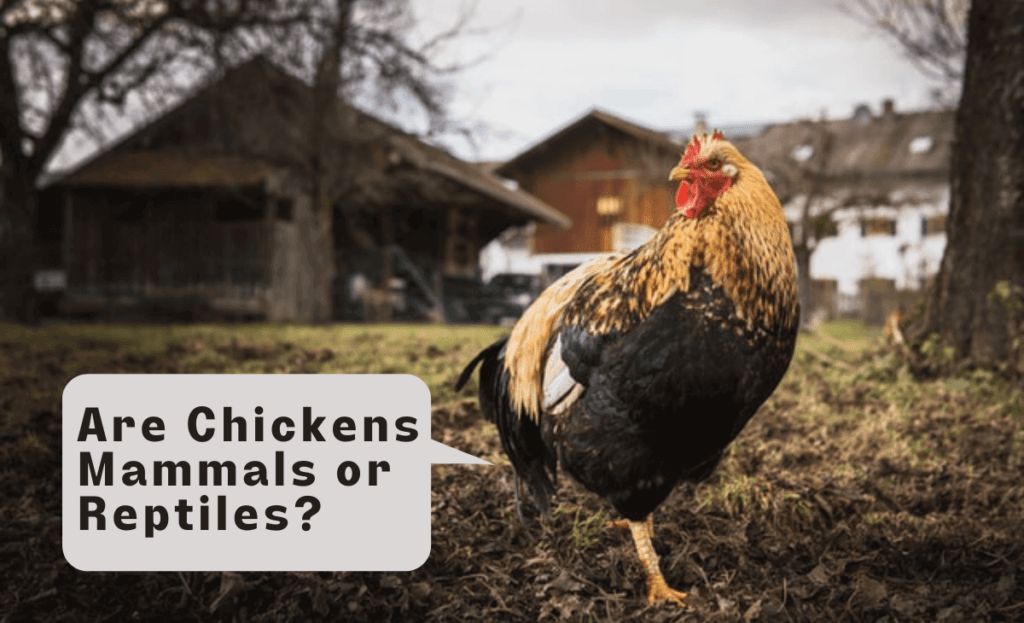Are chickens mammals or reptiles? Unlike most other birds, the chicken is quite complex and possesses both characteristics of mammals and reptiles. For this reason, many people are unsure to which animal kingdom it belongs. Scientists and zoologists may find this question easy. Still, it can be confusing for people unfamiliar with the world beyond their backyard flock or farm production levels.
This article will help chicken owners or enthusiasts better understand the classification of chickens. So, let’s take a closer look.
What is a chicken?
A chicken is a domesticated bird kept as a pet or used for eggs and meat. They are omnivorous and eat seeds, insects, small animals, and even human food like raisins or peanuts.
They come in different breeds, colors, and sizes. They are descendants of the Red junglefowl and are the most common bird globally, with more than 20 billion population estimates.
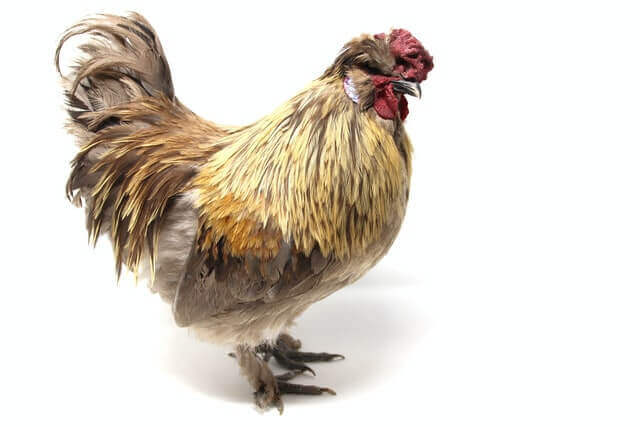
Why Would People Think Chickens Are Mammals or Reptiles?
People often mistake chickens for either mammals or reptiles for a few reasons. One reason is that they have some common traits in both groups. For example, chickens are warm-blooded and have fur or feathers.
They are famous for laying eggs, which is a trait of reptiles. But to better understand, let’s break down the characteristics of both reptiles and mammals.
What is a Reptile?
Reptiles are animals that include snakes, lizards, turtles, and alligators. Unlike mammals and birds, they get their energy from the environment rather than generating it internally. This trait makes them ectothermic.
They must bask in the sun or use an external heat source to warm their bodies. They also have scaly skin that sheds and grows continuously.
What is a Mammal?
Mammals belong to the animal class that includes humans, dogs, cats, and whales. Mammals are warm-blooded, generating internal heat to keep their bodies functioning.
They also have fur or hair, which helps maintain their body temperature. Another trait is that mammals nurse their young with milk from their mammary glands.
Chicken Traits That Are Mammalian and Reptilian
Some chickens have mammalian and reptilian traits, making them difficult to classify. Let’s see some of the characteristics they all share.
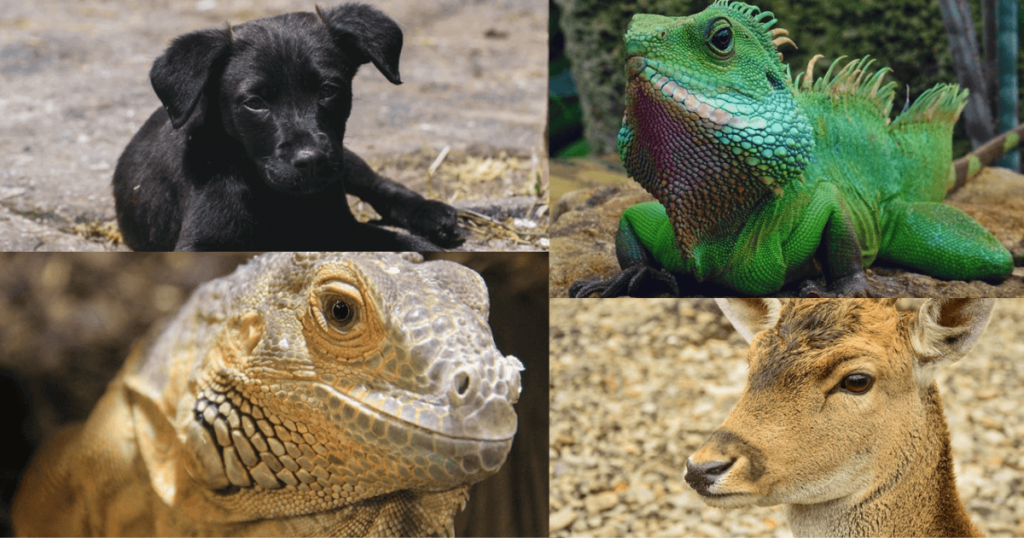
Mammalian
Warm-Blooded: Like mammals, chicks can generate internal heat to keep their bodies functioning. However, their body is operating at temperatures between 105° to 107° Fahrenheit (or 41° to 42° Celsius), which is slightly warmer than mammals.
Reptilian
Lay Egg: Hens lay eggs like reptiles. The eggs come out of the oviduct, an organ that reptiles and birds have in common. Most reptiles lay eggs with soft shells. However, some egg-laying reptiles lay hard-shelled eggs, unlike chicken eggs.
Reptiles and birds use an egg tooth for the purpose of breaking out of their shell. Typically the egg tooth is shed shortly after hatching.
Scaly Skin: Chicks have scaly skin like the reptile family that sheds and grows continuously, especially on their feet, head, neck, and upper chest.
Movable Eyelids: Chickens have movable eyelids, which allow them to see in different directions. It is also a trait that reptiles have.
Layered Eggs: Hens lay eggs with a leathery shell. It has a thin outer layer to protect the egg and a thicker inner layer that helps keep the embryo warm, also a trait of reptilian eggs.
Mammalian and Reptilian traits that chickens DO NOT have
So, chickens have mammalian and reptile characteristics, but not all.
- They lay their eggs in dry environments, like on the ground or in nests, rather than in water. They also do not shed their skin like snakes and other reptiles. Reptiles are also cold-blooded.
- Unlike mammals that give birth to live young, a mother hen stows eggs which hatch into baby chicks. Also, mammals have mammary glands that produce milk for nursing their young. On the other hand, chickens don’t possess mammary glands, making them different from female mammals. Hens do not produce crop milk, so chicks need not rely on their mothers for food.
As you can see, chicks share some traits with mammals and reptiles, but overall, they can be neither mammals nor reptiles. Chicks belong to Aves while reptiles and mammals belong to very different groups.
What Makes a Chicken a Bird? Birds Lay Eggs
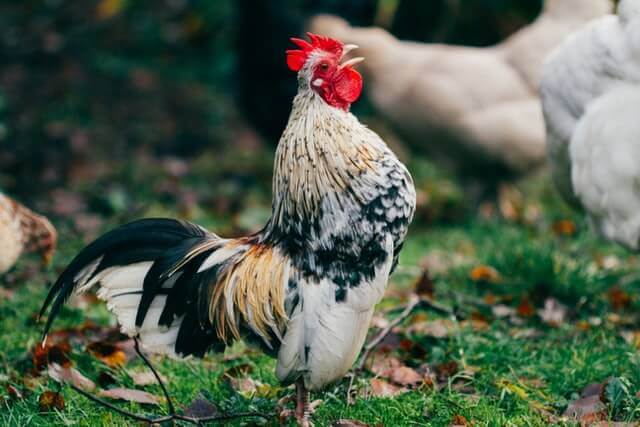
Even though these birds share some characteristics with reptiles and mammals, chickens belong to the class Aves of the phylum Chordata. There are 10,000 species of birds or more in the Aves family, or “bird class.” It is thought that early birds evolved from theropod dinosaurs while mammals evolved from Therapsida.
Birds have the following distinctive characteristics:
Common Characteristics of Chickens as Birds
- Feathers. Chickens have feathers like all birds, which help them stay warm and regulate their body temperature. They are the only class of animals that have feathers.
- Beaks. They have beaks like other birds, which they use to eat food. Its beak contains keratin, the same material that makes up hair and nails.
- Comb and Wattles. They have a comb on their head and wattles on their neck. The comb regulates the temperature, while the wattles attract mates and intimidate predators.
- Feet and Claws. They have feet and claws, which they use to walk, climb, and scratch.
- Voice. Hens, roosters, and chicks make various sounds, including clucking, crowing, and babbling.
What are the practical uses for chickens?
There are many reasons people might keep a chicken. Some common reasons are
Chickens Lay Eggs and Provide Meat
Chickens lay eggs nearly every day, so a new egg supply is always available. They are also a healthy source of meat. You can cook them anytime and at any stage of their life, from chicks to old hens. They are a healthy source of protein.
As pets
You can keep chicks as pets. They are known to be friendly and pleasant animals. Some breeds known to be social are Silkies, Ameraucana, Frizzle Cochins, and Buff Brahma.
For getting rid of pests
Chickens are usable and helpful for getting rid of pests in the yard or garden. They eat insects, slugs, and other small insects that can harm plants.
To help with composting
In agriculture, chickens help with the decomposition of organic materials and turn them into the soil. Their manure is also a highly effective fertilizer for gardens and compost piles.
Scientific Research
Chickens can also be used in scientific research, as they are domesticated birds. Researchers use chickens in human diseases such as cancer and Alzheimer’s. For example, researchers discovered that chicken feathers help reduce inflammation caused by arthritis.
Arts
The feathers and eggshells of chickens are useful in arts and crafts such as jewelry, decoupage, etc.
Cockfight
Some cultures use chickens in cockfights. It is a competition in a ring between two roosters to see which one can kill the other.
Why do chickens have a higher body temperature than mammals?

One of the reasons they have a higher body temperature than mammals is that they generate heat by contracting their muscles. It is known as shivering thermogenesis.
Chickens also use their feathers to keep warm. Feathers are an insulator and help trap air close to the body, which helps keep the bird warm. Another reason for their high body temperature is their high metabolic rate. Unlike mammals, their bodies use more energy to maintain vital functions like breathing and heart rate.
Together, these factors help explain why chickens have a higher temperature than mammals.
Do chickens live longer than mammals and reptiles?
A typical chicken will die earlier than most mammals or reptiles due to their smaller size. However, many factors affect how long each type can last, including their diet.
The quality of protein intake, hydration levels, and exposure temperature are factors we need to consider. It is advisable to have a care guide for feeding chickens.
Unfortunately, chickens die mainly from being cooked.
In lab studies and field trials, over 5000 birds from North America died before their eggs hatched due to cooking.
FAQs (Frequently Asked Questions)
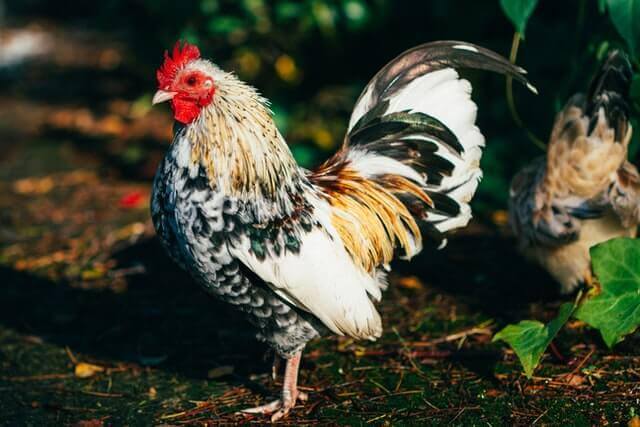
Are chickens endangered?
No, there are more chickens in the world than any other bird. There are more chickens than any other land animal on Earth.
Do chickens migrate?
No, chickens do not migrate. They are known to be nonmigratory birds.
Are Chickens Dangerous?
No, chickens are not generally dangerous. They may peck or attack if they feel threatened, but they are not known to be very aggressive animals.
Are Chickens Herbivores, Carnivores, or Omnivorous?
Chickens are omnivorous, which means they eat both plants and animals. They typically eat seeds, insects, and other small animals.
How many types of chicken are there?
There are approximately 400 different chicken breeds that exist today. However, not all of these breeds are common. The most common species are the White Leghorn, Rhode Island Red, and Plymouth Rock.
So, what are chickens?
Chickens are fascinating animals that share some characteristics with both mammals and reptiles. However, the most common view of chickens is that they are birds.
Their features, abilities, and characteristics explain why this is so. Chickens have their place in the animal kingdom. They play an essential role in agriculture, scientific research, livestock, and poultry keeping.

